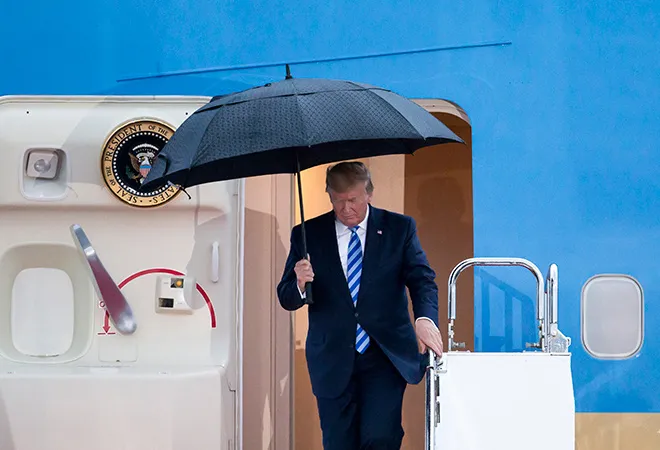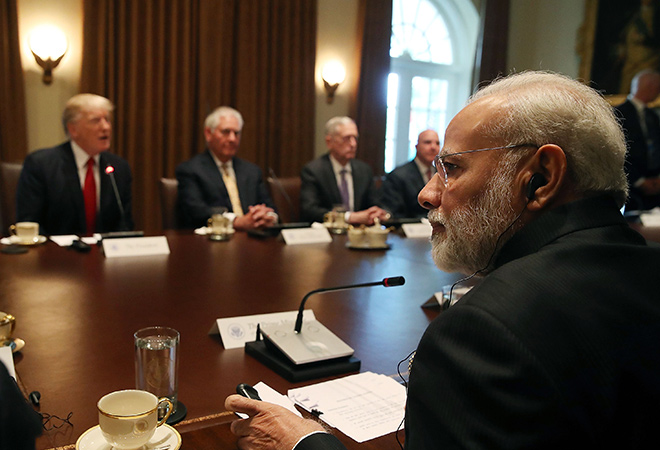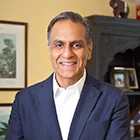
As President Trump prepares to meet Chinese President Xi Jinping in Osaka on the sidelines of the G20 this week, the world is closely watching whether the two leaders can ease trade tensions and calm afflicted global markets. But, just as relevant and perhaps even more so — given the US-China trade war — is a meeting scheduled between President Trump and Indian Prime Minister Narendra Modi.
The meeting between Trump and Modi could not come at a more pressing moment. Both the United States and India remain mired in trade talks that collapsed last month. Now, Washington is revoking a major trade preference programme for India and New Delhi is imposing retaliatory tariffs on a range of US exports. India’s decision to purchase a major air defence system from Russia has also risked US retaliation, while Trump’s mandate to New Delhi to reduce Iranian oil imports to zero has roiled the relationship even further.
Despite these challenges, Trump and Modi have an opportunity to pledge greater cooperation. For nearly two decades, the bipartisan consensus in the United States was to support India’s rise. The rationale for this approach was straightforward: a strong and prosperous India is not only good for the people of India, but also imperative to help reinforce the democratic order, especially in Asia, and this was critical to US interests as well. In recent years — under both Republican and Democratic administrations — both countries have become increasingly aligned, seeing the promise in a free and open Indo-Pacific and engaging in more trade, commercial activity as well as people to people exchanges.
For nearly two decades, the bipartisan consensus in the United States was to support India’s rise. The rationale for this approach was straightforward: a strong and prosperous India is not only good for the people of India, but also imperative to help reinforce the democratic order, especially in Asia, and this was critical to US interests as well.
So, what does this mean for the G20? While these meetings can be short and perfunctory, the Trump-Modi meeting should take on a more ambitious agenda focusing on four areas of importance.
First, it is absolutely critical to get the trade talks back on line. The willingness to engage, even in the midst of complex disagreements, is one of the signature elements of US-India cooperation in the past two decades. In many ways, the trade issues of today are dwarfed by the larger strategic threats and opportunities that both nations collectively face. The trade issues also seem eminently solvable, but they can only be resolved through rigorous and regular dialogue by committed officials who have been directed to find solutions by their respective heads of state.
 Trump and Modi have an opportunity to pledge greater cooperation. Image source: Getty
Trump and Modi have an opportunity to pledge greater cooperation. Image source: Getty
Second, solving the trade talks requires a commitment from both nations to engage in an open, predictable and rules based set of commercial exchanges. Both sides must acknowledge past mistakes in this regard. Invoking US national security grounds to impose tariffs on Indian steel and aluminum, for example, was hardly credible. Likewise, India’s attempts to mandate the localisation of data, affix price controls and change rules suddenly on e-commerce platforms created a significant loss of confidence from foreign investors. Both countries can benefit from the massive investment opportunities provided by a stable, predictable and transparent business environment, especially given the uncertainty over US supply chains involving China.
Read | Strategic Convergence: The United States and India as Major Defence Partners
Third, strategic cooperation should enter a new and elevated phase. India is the only country that Washington has designated as a Major Defence Partner — a label that allows for substantial defence cooperation without the traditional alliance framework. As a Major Defence Partner, the United States should treat India akin to a NATO ally and continue to support transfers of advanced technology and arms. Additionally, Trump should take off the table potential sanctions related to Indian purchases of advanced Russian military equipment and Iranian oil. In return, India should recognise the full promise of a security partnership with the United States. Cooperating on joint humanitarian missions or more complex military exercises, for example, would demonstrate India’s commitment to increased burden sharing and also serve as a reminder to potential adversaries about the promise of a US-India security partnership.
When visiting Delhi 60 years ago on a state visit, President Eisenhower asked a group of children at the US Embassy what he thought the world would be like when they were his age: “What would the world be like in 2019?” He was worried about the path we were on, but noted in the end: the promise of the US and Indian people working together would help set the world on a better path.
And finally, Trump should commit to visiting India later this year. The history of the US-India relationship shows that personal ties matter, particularly between the heads-of-government. Presidents Eisenhower, Kennedy, George W. Bush and Obama all developed close, working relationships with their Indian counterparts. Such relationships are essential to breaking through each country’s complex bureaucracies. Overcoming the hesitations of history as Prime Minister Modi has spoken about is essential to advancing US-India relations and that starts at the very top through personal rapport and trust. Such a visit could be history in making.
When visiting Delhi 60 years ago on a state visit, President Eisenhower asked a group of children at the US Embassy what he thought the world would be like when they were his age: “What would the world be like in 2019?” He was worried about the path we were on, but noted in the end: the promise of the US and Indian people working together would help set the world on a better path. Eisenhower’s remarkable prediction about this year — and the potential of the people — was exactly right. Now, it’s time to turn that vision into a reality.
The views expressed above belong to the author(s). ORF research and analyses now available on Telegram! Click here to access our curated content — blogs, longforms and interviews.




 Trump and Modi have an opportunity to pledge greater cooperation. Image source: Getty
Trump and Modi have an opportunity to pledge greater cooperation. Image source: Getty PREV
PREV


